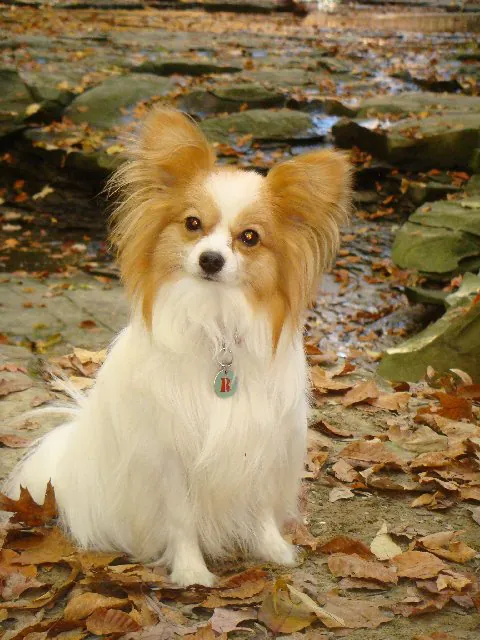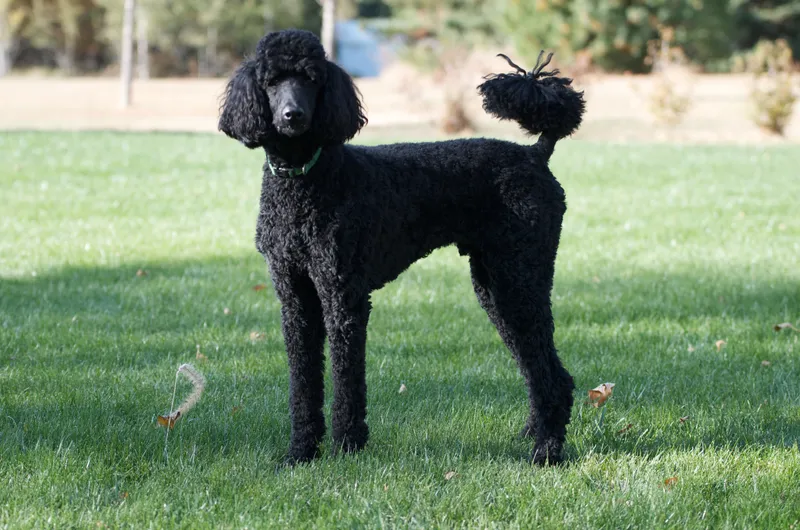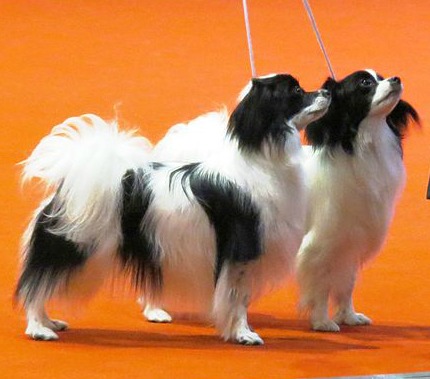Cavalier King Charles Spaniel
The Cavalier King Charles Spaniel is a small, affectionate breed known for its gentle nature and playful spirit. Ideal for families and individuals, they thrive on companionship and enjoy both indoor cuddles and outdoor adventures.
Overview
🐕Breed Overview
✨Key Traits
💡What Makes Cavalier King Charles Spaniel Special
The Cavalier King Charles Spaniel is characterized by its affectionate and gentle temperament. They are known for their sociability, making them excellent companions for families, children, and other pets.
Their intelligence and eagerness to please make training relatively easy, although they may require consistent reinforcement to stay focused. Cavaliers enjoy both indoor cuddling and outdoor adventures, showcasing their versatility as both lapdogs and active companions.
Their charming appearance, with long, silky coats and expressive eyes, adds to their appeal as a beloved breed.
The Cavalier King Charles Spaniel is a charming and affectionate toy breed that has captured the hearts of dog lovers around the world. With a history steeped in royal tradition, these small dogs were once the favored companions of English nobility, particularly King Charles II. Their gentle demeanor and sweet expressions make them ideal lapdogs, while their playful nature ensures they enjoy outdoor adventures just as much.
Standing at 12 to 13 inches tall and weighing between 13 to 18 pounds, Cavaliers are perfectly sized for both families and individuals alike. Their silky, moderately long coats come in a variety of colors, including the popular Blenheim (red and white) and tricolor (black, white, and tan). Regular grooming is essential to keep their coats looking their best, requiring brushing every few days to prevent matting.
Cavaliers are known for their friendly and sociable personalities, making them excellent companions for children and other pets. They thrive on human interaction and are eager to please, which contributes to their ease of training. While they may not be the best watchdogs due to their friendly nature, their affectionate disposition makes them beloved family members.
Daily exercise is important for their physical and mental well-being, with walks and playtime being essential parts of their routine. Despite some common health concerns, such as heart conditions and patellar luxation, with proper care and regular veterinary check-ups, Cavaliers can lead long, happy lives, often reaching an average lifespan of 9 to 14 years. Whether cuddling on the couch or exploring the great outdoors, the Cavalier King Charles Spaniel is a delightful breed that brings joy and companionship to any home.
🎉Fun Facts
Cavaliers are known for their expressive, large, dark eyes that give them a sweet and gentle appearance.
Cavaliers were known as 'comforter spaniels' in the Tudor period, often used as lapdogs by the aristocracy.
King Charles II was so fond of these dogs that he was rarely seen without one, leading to their royal association.
They are one of the largest breeds in the toy group, making them sturdy yet small companions.
They have a unique ability to adapt to various living situations, from apartments to larger homes.
Breed Characteristics
Family & Friends
Good Behavior
Get Up & Go
Household Harmony
Temperament & Personality
✨Key Traits
🐕Core Temperament
The Cavalier King Charles Spaniel is known for its sweet and gentle temperament. They are friendly and sociable, getting along well with children, other dogs, and even strangers.
Their affectionate nature makes them ideal lapdogs, and they thrive on human companionship. Cavaliers are playful and enjoy engaging in activities, but they are also content to relax and cuddle with their families.
They are generally calm and do not exhibit aggressive behaviors, making them excellent family pets. Their temperament is characterized by a desire to please and a friendly disposition, which contributes to their popularity as companion animals.
💫Personality Profile
Cavalier King Charles Spaniels are known for their friendly and gentle personalities. They are affectionate dogs that thrive on human companionship and are eager to please their owners.
Their playful nature makes them great companions for children and other pets, as they enjoy interactive play and socialization. Cavaliers are generally calm and quiet, making them suitable for various living environments.
They are intelligent and respond well to training, although they can be easily distracted by their surroundings. Overall, their sweet disposition and sociable nature make them beloved family members.
🔊Vocal Tendencies
Cavalier King Charles Spaniels are generally not excessive barkers, earning a low barking tendency rating. They may bark to alert their owners of visitors or unusual sounds, but they are more likely to greet strangers with friendliness rather than aggression.
Their vocalizations are typically soft and gentle, reflecting their calm demeanor. While they may express excitement during play or when greeting family members, they do not have a reputation for being noisy dogs.
Overall, their moderate noise level makes them suitable for various living situations without causing disturbances.
Affection & Social Traits
Energy & Activity
Communication Style
Care Requirements
🏃♂️Exercise Requirements
Daily Exercise
The Cavalier King Charles Spaniel is a moderately active breed that requires regular exercise to maintain its health and happiness. Ideally, they should engage in at least 30 to 60 minutes of exercise each day, which can be broken down into several short walks or play sessions.
Activities such as leisurely walks, fetch, or gentle playtime in a secure yard are excellent for this breed. Puppies may require shorter bursts of activity, while older dogs may benefit from more gentle exercise to accommodate their energy levels and health.
Regular exercise helps prevent obesity, supports cardiovascular health, and contributes to their overall mental well-being. Insufficient exercise can lead to weight gain, behavioral issues, and increased anxiety, so it's essential to keep them active and engaged.
Preferred Activities
🏠Living & Adaptability
Space Requirements
Cavalier King Charles Spaniels are adaptable and can thrive in various living environments, including apartments and homes with small yards. They do not require vast amounts of space but benefit from a secure area to play and explore.
For apartment dwellers, regular walks and trips to parks are essential to meet their exercise needs. Owners should ensure that their living space is dog-proofed, as Cavaliers are curious and may explore their surroundings.
A small backyard is ideal, but they can also be happy in urban settings as long as they receive adequate exercise and mental stimulation.
Climate Preference
🍲Feeding Guide
Schedule
Food Types
Portion Size
Special Nutritional Needs
Cavalier King Charles Spaniels may have specific dietary needs due to their predisposition to certain health issues, such as heart disease. A diet rich in omega fatty acids can support skin and coat health, while antioxidants can help maintain overall health. It's essential to monitor their weight and adjust portions accordingly to prevent obesity.
✨Grooming Requirements
Grooming Overview
The Cavalier King Charles Spaniel has a long, silky coat that requires regular grooming to keep it healthy and free from tangles. Brushing should be done every other day to prevent matting, focusing on the ears, chest, legs, and tail, where feathering is prominent.
Bathing should be done as needed, typically every 4 to 6 weeks, using a gentle dog shampoo. Regularly check and clean their ears to prevent infections, and trim their nails every few weeks to keep them at a comfortable length.
Daily cleaning of their eyes with a warm, damp cloth can help prevent tear staining.
Care Schedule
Brush every other day; bathe every 4-6 weeks; trim nails every 2-3 weeks.
Health Profile
⚕️Health Care
Regular health care is vital for maintaining the lifespan of Cavalier King Charles Spaniels. Routine veterinary check-ups, vaccinations, and preventive treatments are essential to catch any health issues early.
Owners should also monitor their dog's weight and overall health, providing a balanced diet and regular exercise to promote longevity. Early detection of health problems can lead to more effective management and treatment, contributing to a longer, healthier life for these beloved companions.
Health Issues Overview
⏳Average Lifespan
Genetic Factors
Genetics play a significant role in the lifespan of Cavalier King Charles Spaniels, particularly concerning hereditary health issues. Responsible breeding practices that prioritize genetic diversity and health testing can help reduce the risk of inherited conditions.
Potential owners should seek reputable breeders who conduct health screenings for common breed-specific issues, ensuring that their puppies come from healthy lineage. Understanding the genetic predispositions of the breed can help owners make informed decisions about their care and management.
Living Conditions
Cavalier King Charles Spaniels thrive in environments that provide companionship and regular interaction with their families. They do well in both urban and rural settings, as long as they receive adequate exercise and mental stimulation.
A loving home with access to outdoor spaces for exploration and play can significantly enhance their quality of life and longevity. Social interactions with humans and other pets are crucial for their emotional well-being, and a stable, nurturing environment can help them live longer, healthier lives.
🏥Common Health Issues
Mitral Valve Disease
Warning Signs
🔬Diagnosis
Veterinarians typically diagnose this condition through physical examinations, echocardiograms, and X-rays.
💊Treatment
Medications such as diuretics, ACE inhibitors, and beta-blockers may be prescribed to manage symptoms.
📝Management Tips
Regular veterinary check-ups, maintaining a healthy weight, and providing a low-sodium diet can help manage this condition.
Patellar Luxation
Warning Signs
🔬Diagnosis
Diagnosis is usually made through physical examination and X-rays.
💊Treatment
Surgical options may include realignment of the kneecap.
📝Management Tips
Weight management and physical therapy can help manage this condition; in severe cases, surgical intervention may be necessary.
Hip Dysplasia
Warning Signs
🔬Diagnosis
Diagnosis is made through X-rays and physical examinations.
💊Treatment
Medications and, in severe cases, surgical options may be recommended.
📝Management Tips
Maintaining a healthy weight and providing joint supplements can help manage symptoms.
Syringomyelia
Warning Signs
🔬Diagnosis
Diagnosis is typically made through MRI scans.
💊Treatment
Medications may be prescribed to manage pain and discomfort.
📝Management Tips
Regular veterinary check-ups and monitoring for symptoms can help manage this condition.
Brachycephalic Airway Obstruction Syndrome
Warning Signs
🔬Diagnosis
Diagnosis is made through physical examination and observation of breathing patterns.
💊Treatment
Surgical options may be considered in severe cases.
📝Management Tips
Weight management and avoiding extreme heat can help manage symptoms.
🛡️Preventive Care
🔬Cardiac Evaluation
This test assesses the heart's function and structure, helping to identify any abnormalities or conditions such as mitral valve disease.
📅 Annually after the age of 5 years.
🔬Hip Evaluation
This test evaluates the hips for dysplasia, a common issue in the breed that can lead to pain and mobility problems.
📅 At 2 years of age and then every 2 years thereafter.
🔬Knee Evaluation
This test checks the knees for patellar luxation, which is a common concern in small breeds like the Cavalier.
📅 Annually after the age of 1 year.
🔬Eye Examination
This test assesses the eyes for hereditary conditions that can affect vision, such as retinal dysplasia.
📅 Annually after the age of 1 year.
Training
🧠Intelligence & Trainability
💪Work Drive
Cavalier King Charles Spaniels have a moderate work drive, primarily stemming from their history as companion and flushing dogs. They enjoy engaging in activities that stimulate their minds and bodies, such as obedience training, agility, and interactive play.
Providing them with tasks or challenges, like scent work or puzzle toys, can help satisfy their need for mental engagement. Regular exercise and playtime are essential to keep them happy and prevent boredom-related behaviors.
⚠️Training Considerations
Cavalier King Charles Spaniels are generally eager to please, but they can be prone to distractions during training due to their curious nature. Common challenges include their tendency to chase small animals or become overly excited during play.
To overcome these challenges, consistent training methods, positive reinforcement, and engaging activities are essential. Socialization from a young age can help them learn appropriate behaviors around other pets and people.
Additionally, providing mental stimulation through puzzle toys and interactive games can keep them focused and reduce unwanted behaviors.
📝Training Tips
Training a Cavalier King Charles Spaniel can be a rewarding experience, as they are intelligent and responsive to commands. Positive reinforcement techniques, such as treats and praise, work best for this breed.
Start with basic commands like 'sit,' 'stay,' and 'come,' and gradually introduce more complex tasks. Short, frequent training sessions are ideal, as they maintain the dog's interest and prevent boredom.
Socialization is crucial, so expose them to various environments, people, and other animals to help them develop into well-rounded adults. Consistency and patience are key, as Cavaliers thrive on routine and clear expectations.
History & Heritage
📜Origin Story
The Cavalier King Charles Spaniel's story begins in the courts of England during the Tudor period, where small spaniels were cherished companions of nobility. These dogs were often depicted in paintings and were known for their affectionate nature.
King Charles II, who ruled in the 17th century, was particularly enamored with these dogs, often seen with them by his side. His love for the breed led to its association with royalty, and they became known as King Charles Spaniels.
Over time, the breed evolved, and in the 1920s, efforts to revive the original type led to the establishment of the Cavalier King Charles Spaniel as a distinct breed. Today, they are celebrated for their gentle temperament and charming appearance, making them popular companions worldwide.
⏳Development History
The Cavalier King Charles Spaniel's lineage can be traced back to the 16th century, with ancestors that were small spaniels favored by the aristocracy. The breed was shaped by interbreeding with various toy breeds, including the Japanese Chin and the Pekingese.
King Charles II of England was a significant figure in the breed's history, as he adored these dogs and ensured their presence in public life. The breed underwent changes over the years, particularly in the 20th century, when efforts were made to revive the original type of spaniel.
The breed was officially recognized by the AKC in 1996, solidifying its popularity in the United States.
🛡️Purpose & Historical Role
Originally bred as companion dogs, Cavalier King Charles Spaniels were favored by the aristocracy for their affectionate nature and small size, making them ideal lapdogs. They were also used to flush small game, showcasing their spaniel heritage. In modern times, they continue to serve as beloved companions, excelling in roles such as therapy dogs and family pets.
🏺Cultural Significance
The Cavalier King Charles Spaniel has a rich history intertwined with British royalty, particularly King Charles II, who was known for his affection for these dogs. They were often depicted in art and literature, symbolizing companionship and luxury.
Their presence in royal courts made them popular among aristocrats, and they were often referred to as 'comforter spaniels' due to their role as lapdogs. This breed's gentle nature and charming appearance have made it a beloved companion in modern households, maintaining its status as a favorite among families and individuals alike.
Conservation Status
This breed is well-established with healthy population numbers.









